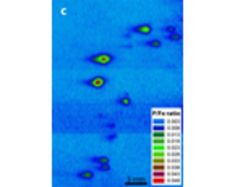Chemical Imaging at UFT
Topical chemical imaging research projects at the BOKU campus Tulln Novel, trans-disciplinary research projects are being conducted at the new BOKU campus in Tulln with a modern, unique instrumental infrastructure in the field of chemical imaging. Among the analytical instruments, an infrared microscope along with a laser ablation system coupled to a high resolution mass spectrometer will be applied to assess the chemical information of solid materials with high spatial resolution.
With help of these modern analytical methods the nutrient dynamics in close proximity to plant roots, the alteration of e.g. paper products during degradation, the distribution of heavy metals in biological matrices (e.g. wood, tissues) and physiological processes (e.g. via stable isotopes) are investigated. Core facilities are the new infrared microscope and a laser ablation system (coupled to a high resolution inductively coupled plasma mass spectrometer) to assess chemical information with high spatial resolution on solid surfaces. The laser ablation system along with the mass spectrometer were financed via the ‚Konjunkturpaket II – ‚Investitionsoffensive der Bundesregierung im Bereich Forschung und Entwicklung zur Modernisierung der Geräte an Universitäten 2009/10’. These instruments are part of the equipment of the BOKU Imaging Center, a trans-disciplinary collaboration of several research groups at the BOKU campus in Tulln. The top end instrumental equipment enables high level research together with highest quality of master and PhD student education. Shortly after the first research groups have started to work in the new buildings in Tulln, two research projects were funded by the Austrian Science Fund (FWF) that will employ the instrumentation of the BOKU Imaging Center. In the project „Chemical imaging of phosphorus dynamics in the rhizosphere“ Prof. Walter Wenzel and his team will investigate the distribution of phosphorus and metals in close vicinity to plant roots (rhizosphere). The data generated via chemical imaging and the resulting conclusions will enhance the knowledge of plant – soil interactions and thereby contribute to selecting nutrient-efficient agricultural crops. The cutting edge facilities at the BOKU Imaging Center are prerequisites for the successful conduction of this highly topical research. The project „Bergwerk Hallstatt: ISOwood - Herkunft von prähistorischem Holz“ (Hallstatt mine: ISOwood – Provenance of prehistoric wood) is a cooperation of the research group of Prof. Thomas Prohaska (VIRIS laboratory), the institute of wood science, the AIT (Tulln) and the Museum of Natural History Vienna. The laser ablation system will be applied for the quasi non-destructive analysis of valuable artifacts for their isotopic and elemental composition. The wooden artifacts stem from the archaeological excavation site in Hallstatt. The resulting method for determining the provenance of wood will not only be used to reconstruct prehistoric trade routes and the supply structure of a prehistoric industrial site but also applied for determination of authenticity and provenance of todays traded wood. Additional projects currently in preparation include the further investigation of paper degradation (forMuse project of the research group around Prof. Thomas Rosenau) and a project which aims to investigate the degradation products of newly developed bone implant material and their distribution in organs and the bone tissue. Phosphate and pH chemical image in the vicinity of a corn maize. (a) Photographic image of a maize root. (b) Alkalinisation (Increase of pH) along this root as induced by fertilisation with NO3 (relative pH changes only). (c) Distribution of phosphate around the root. These measurements were done by Eva Oburger and Jakob Santner, Institute of Soil Science.

